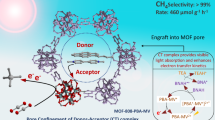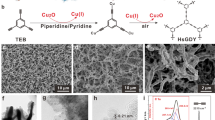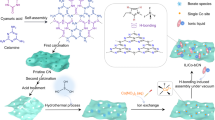Abstract
The selective reduction of CO2 with inexpensive solar-driven photoelectrochemical devices is a contemporary challenge in the quest for renewable fuel production. Here, we report a molecular catalyst-based photocathode assembled from precious-metal-free components that is active towards aqueous CO2 reduction. The reported photocathode is based on a phosphonated cobalt bis(terpyridine) catalyst that is interfaced via a mesoporous TiO2 scaffold with a light-harvesting p-type silicon electrode. The hybrid photoelectrode reduces CO2 to CO in both organic-water and purely aqueous conditions, achieving a turnover number of ~330 and maintaining stable activity for more than one day. Critically, in-depth electrochemical as well as in situ resonance Raman and infrared spectroelectrochemical investigations alluded to a catalytic mechanism that differs to that reported for the soluble metal bis(terpyridine) catalyst as the consequence of the immobilization. In addition, it further unlocks an earlier catalytic onset and better electrocatalytic performance while enabling aqueous CO2 reduction with the reported photocathode.
This is a preview of subscription content, access via your institution
Access options
Access Nature and 54 other Nature Portfolio journals
Get Nature+, our best-value online-access subscription
$29.99 / 30 days
cancel any time
Subscribe to this journal
Receive 12 digital issues and online access to articles
$119.00 per year
only $9.92 per issue
Buy this article
- Purchase on Springer Link
- Instant access to full article PDF
Prices may be subject to local taxes which are calculated during checkout








Similar content being viewed by others
Data availability
The data that support the plots within this paper and other findings of this study are available from the corresponding author upon reasonable request.
References
Detz, R. J., Reek, J. N. H. & Van der Zwaan, B. C. C. The future of solar fuels: when could they become competitive? Energy Environ. Sci. 11, 1653–1669 (2018).
Appel, A. M. et al. Frontiers, opportunities, and challenges in biochemical and chemical catalysis of CO2 fixation. Chem. Rev. 113, 6621–6658 (2013).
Takeda, H., Cometto, C., Ishitani, O. & Robert, M. Electrons, photons, protons and earth-abundant metal complexes for molecular catalysis of CO2 reduction. ACS Catal. 7, 70–88 (2016).
Zhang, L., Zhao, Z.-J., Wang, T. & Gong, J. Nano-designed semiconductors for electro- and photoelectro-catalytic conversion of carbon dioxide. Chem. Soc. Rev. 47, 5423–5443 (2018).
Dalle, K. E. et al. Electro- and solar-driven fuel synthesis with first row transition metal complexes. Chem. Rev. 119, 2752–2875 (2019).
Arai, T. et al. Photoelectrochemical reduction of CO2 in water under visible-light irradiation by a p-type InP photocathode modified with an electropolymerized ruthenium complex. Chem. Commun. 46, 6944–6946 (2010).
Sato, S. et al. Selective CO2 conversion to formate conjugated with H2O oxidation utilizing semiconductor/complex hybrid photocatalysts. J. Am. Chem. Soc. 133, 15240–15243 (2011).
Sahara, G. et al. Photoelectrochemical reduction of CO2 coupled to water oxidation using a photocathode with a Ru(ii)–Re(i) complex photocatalyst and a CoOx/TaON photoanode. J. Am. Chem. Soc. 138, 14152–14158 (2016).
Kumagai, H. et al. Hybrid photocathode consisting of a CuGaO2 p-type semiconductor and a Ru(ii)–Re(i) supramolecular photocatalyst: non-biased visible-light-driven CO2 reduction with water oxidation. Chem. Sci. 8, 4242–4249 (2017).
Sekizawa, K., Sato, S., Arai, T. & Morikawa, T. Solar-driven photocatalytic CO2 reduction in water utilizing a ruthenium complex catalyst on p-type Fe2O3 with a multiheterojunction. ACS Catal. 8, 1405–1416 (2018).
Feldman, D. B. et al. Photovoltaic System Pricing Trends: Historical, Recent, and Near-Term Projections (NREL, 2015).
Constable, E. C., Harris, K., Housecroft, C. E., Neuburger, M. & Zampese, J. A. Environmental control of solution speciation in cobalt(ii) 2,2′:6′,2′′-terpyridine complexes: anion and solvent dependence. Dalton Trans. 40, 11441–11450 (2011).
Potts, K. T., Usifer, D. A., Guadalupe, A. & Abruña, H. D. 4-Vinyl-, 6-vinyl-, and 4′-vinyl-2,2′:6′,2′′-terpyridinyl ligands: their synthesis and the electrochemistry of their transition-metal coordination complexes. J. Am. Chem. Soc. 109, 3961–3967 (1987).
Enachescu, C. et al. Optical investigation of spin-crossover in cobalt(ii) bis-terpy complexes. Inorg. Chim. Acta 360, 3945–3950 (2007).
Leung, J. J. et al. Photoelectrocatalytic H2 evolution in water with molecular catalysts immobilised on p-Si via a stabilising mesoporous TiO2 interlayer. Chem. Sci. 8, 5172–5180 (2017).
Guerrero, G., Mutin, P. H. & Vioux, A. Organically modified aluminas by grafting and sol–gel processes involving phosphonate derivatives. J. Mater. Chem. 11, 3161–3165 (2001).
Bae, E. et al. Effects of surface anchoring groups (carboxylate vs phosphonate) in ruthenium-complex-sensitized TiO2 on visible light reactivity in aqueous suspensions. J. Phys. Chem. B 108, 14093–14101 (2004).
Fuchs, P., Hess, U., Holst, H. H. & Lund, H. Electrochemical carboxylation of some heteroaromatic compounds. Acta Chem. Scand. B 35, 185–192 (1981).
Li, Y.-F., Aschauer, U., Chen, J. & Selloni, A. Adsorption and reactions of O2 on anatase TiO2. Acc. Chem. Res. 47, 3361–3368 (2014).
Seger, B. et al. Using TiO2 as a conductive protective layer for photocathodic H2 evolution. J. Am. Chem. Soc. 135, 1057–1064 (2013).
Elgrishi, N., Chambers, M. B., Artero, V. & Fontecave, M. Terpyridine complexes of first row transition metals and electrochemical reduction of CO2 to CO. Phys. Chem. Chem. Phys. 16, 13635–13644 (2014).
Cobo, S. et al. A Janus cobalt-based catalytic material for electro-splitting of water. Nat. Mater. 11, 802–807 (2012).
Chuang, T. J., Brundle, C. R. & Rice, D. W. Interpretation of the X-ray photoemission spectra of cobalt oxides and cobalt oxide surfaces. Surf. Sci. 59, 413–429 (1976).
Matsubara, Y. Standard electrode potentials for the reduction of CO2 to CO in acetonitrile–water mixtures determined using a generalized method for proton-coupled electron-transfer reactions. ACS Energy Lett. 2, 1886–1891 (2017).
Perry, R. H. Perry’s Chemical Engineers’ Handbook 8th edn (McGraw-Hill, New York, 2008).
Heinzel, A. B., Teschner, D. M. & Schumacher, R. Influence of water on the capacitance/potential distribution at the TiO2/CH3CN junction. Ber. Bunsenges. Phys. Chem. 85, 1117–1119 (1981).
Sumita, M., Sodeyama, K., Han, L. & Tateyama, Y. Water contamination effect on liquid acetonitrile/TiO2 anatase (101) interface for durable dye-sensitized solar cell. J. Phys. Chem. C 115, 19849–19855 (2011).
Enright, B., Redmond, G. & Fitzmaurice, D. Spectroscopic determination of flatband potentials for polycrystalline TiO2 electrodes in mixed solvent systems. J. Phys. Chem. 98, 6195–6200 (1994).
Won, D. I. et al. Highly robust hybrid photocatalyst for carbon dioxide reduction: tuning and optimization of catalytic activities of dye/TiO2/Re(i) organic–inorganic ternary systems. J. Am. Chem. Soc. 137, 13679–13690 (2015).
Sahara, G. et al. Photoelectrochemical CO2 reduction using a Ru(ii)–Re(i ) multinuclear metal complex on a p-type semiconducting NiO electrode. Chem. Commun. 51, 10722–10725 (2015).
Apaydin, D. H. et al. Photoelectrochemical reduction of CO2 using third-generation conjugated polymers. ChemistrySelect 1, 1156–1162 (2016).
Schreier, M. et al. Covalent immobilization of a molecular catalyst on Cu2O photocathodes for CO2 reduction. J. Am. Chem. Soc. 138, 1938–1946 (2016).
Kumar, B., Smieja, J. M. & Kubiak, C. P. Photoreduction of CO2 on p-type silicon using Re(bipy-But)(CO)3Cl: photovoltages exceeding 600 mV for the selective reduction of CO2 to CO. J. Phys. Chem. C 114, 14220–14223 (2010).
Alenezi, K., Ibrahim, S. K., Li, P. & Pickett, C. J. Solar fuels: photoelectrosynthesis of CO from CO2 at p-type Si using Fe porphyrin electrocatalysts. Chem. Eur. J. 19, 13522–13527 (2013).
Torralba-Peñalver, E., Luo, Y., Compain, J.-D., Chardon-Noblat, S. & Fabre, B. Selective catalytic electroreduction of CO2 at silicon nanowires (SiNWs) photocathodes using non-noble metal-based manganese carbonyl bipyridyl molecular catalysts in solution and grafted onto SiNWs. ACS Catal. 5, 6138–6147 (2015).
Elgrishi, N., Chambers, M. B., Wang, X. & Fontecave, M. Molecular polypyridine-based metal complexes as catalysts for the reduction of CO2. Chem. Soc. Rev. 46, 761–796 (2017).
Šloufová, I., Vlčková, B., Procházka, M., Svoboda, J. & Vohlídal, J. Comparison of SERRS and RRS excitation profiles of [Fe(tpy)2]2+ (tpy=2,2′:6′,2′′-terpyridine) supported by DFT calculations: effect of the electrostatic bonding to chloride-modified Ag nanoparticles on its vibrational and electronic structure. J. Raman Spectrosc. 45, 338–348 (2014).
Keidel, A. et al. Electrochemical and resonance Raman spectroscopic studies of water-oxidizing ruthenium terpyridyl–bipyridyl complexes. ChemSusChem 10, 551–561 (2017).
Ly, H. K. et al. 2nd coordination sphere controlled electron transfer of iron hangman complexes on electrodes probed by surface enhanced vibrational spectroscopy. Chem. Sci. 6, 6999–7007 (2015).
Hugot-Le Goff, A., Joiret, S. & Falaras, P. Raman resonance effect in a monolayer of polypyridyl ruthenium(ii) complex adsorbed on nanocrystalline TiO2 via phosphonated terpyridyl ligands. J. Phys. Chem. B 103, 9569–9575 (1999).
Sun, Y. et al. Molecular cobalt pentapyridine catalysts for generating hydrogen from water. J. Am. Chem. Soc. 133, 9212–9215 (2011).
Yaguchi, M., Uchida, T., Motobayashi, K. & Osawa, M. Speciation of adsorbed phosphate at gold electrodes: a combined surface-enhanced infrared absorption spectroscopy and DFT study. J. Phys. Chem. Lett. 7, 3097–3102 (2016).
Arai, Y. & Sparks, D. L. ATR–FTIR spectroscopic investigation on phosphate adsorption mechanisms at the ferrihydrite–water interface. J. Colloid Interface Sci. 241, 317–326 (2001).
Yoshida, T., Iida, T., Shirasagi, T., Lin, R.-J. & Kaneko, M. Electrocatalytic reduction of carbon dioxide in aqueous medium by bis(2,2′: 6′,2′′-terpyridine)cobalt(ii) complex incorporated into a coated polymer membrane. J. Electroanal. Chem. 344, 355–362 (1993).
Rooth, M. & Shaw, A. M. Interfacial pH and surface pK a of a thioctic acid self-assembled monolayer. Phys. Chem. Chem. Phys. 8, 4741–4743 (2006).
White, H. S., Peterson, J. D., Cui, Q. & Stevenson, K. J. Voltammetric measurement of interfacial acid/base reactions. J. Phys. Chem. B 102, 2930–2934 (1998).
Bjorneholm, O. et al. Water at interfaces. Chem. Rev. 116, 7698–7726 (2016).
He, T. et al. Electron trapping induced electrostatic adsorption of cations: a general factor leading to photoactivity decay of nanostructured TiO2. J. Mater. Chem. A 5, 6455–6464 (2017).
Aroua, S. et al. New cobalt-bisterpyridyl catalysts for hydrogen evolution reaction. ChemCatChem 9, 2099–2105 (2017).
Guadalupe, A. R. et al. Novel chemical pathways and charge-transport dynamics of electrodes modified with electropolymerized layers of [Co(v-terpy)2]2+. J. Am. Chem. Soc. 110, 3462–3466 (1988).
Veldkamp, B. S. et al. Photoinitiated multi-step charge separation and ultrafast charge transfer induced dissociation in a pyridyl-linked photosensitizer-cobaloxime assembly. Energy Environ. Sci. 6, 1917–1928 (2013).
Nazeeruddin, M. K., Zakeeruddin, S. M., Humphry-Baker, R., Kaden, T. A. & Grätzel, M. Determination of pK a values of 4-phosphonato-2,2′:6′,2′′-terpyridine and its ruthenium(ii)-based photosensitizer by NMR, potentiometric, and spectrophotometric methods. Inorg. Chem. 39, 4542–4547 (2000).
Reuillard, B. et al. Tuning product selectivity for aqueous CO2 reduction with a Mn(bipyridine)-pyrene catalyst immobilized on a carbon nanotube electrode. J. Am. Chem. Soc. 139, 14425–14435 (2017).
Hogg, R. & Wilkins, R. G. Exchange studies of certain chelate compounds of the transitional metals. Part VIII. 2,2′,2′′-terpyridine complexes. J. Chem. Soc. 341–350 (1962).
Lanning, J. A. & Chambers, J. Q. Voltammetric study of the hydrogen ion/hydrogen couple in acetonitrile/water mixtures. Anal. Chem. 45, 1010–1016 (1973).
Ly, H. K. et al. Perturbation of the redox site structure of cytochrome c variants upon tyrosine nitration. J. Phys. Chem. B 116, 5694–5702 (2012).
Acknowledgements
The authors acknowledge support from the Woolf Fisher Trust in New Zealand (J.J.L.), the Christian Doppler Research Association (Austrian Federal Ministry for Digital and Economic Affairs and the National Foundation for Research, Technology and Development) and the OMV Group (J.W., M.F.K. and E.R.), an ERC Consolidator Grant ‘MatEnSAP’ (682833; N.H. and E.R.), the European Union’s Horizon2020 research and innovation programme (Marie Sklodowska-Curie fellowship for K.H.L., GAN 701192) and the National Research Foundation via the Creative Research Initiative Center (Republic of Korea, grant no. NRF-2015R1A3A2066191; D.H.N.). The authors thank D. Morgan (Cardiff Catalysis Institute, Cardiff University) for help with XPS measurements and P. Hildebrandt (Institut für Chemie, Technische Universität Berlin) for granting access to his Raman facilities.
Author information
Authors and Affiliations
Contributions
J.J.L., J.W. and E.R. conceived the research. J.W. synthesized and characterized CotpyP. J.J.L., J.W. and D.H.N. prepared the electrodes. J.J.L. and J.W. carried out physical characterization of the electrodes, J.J.L. the (photo)electrochemical experiments, K.H.L. the spectroelectrochemical resonance Raman measurements and N.H. and J.J.L. the spectroelectrochemical ATR-IR measurements. J.J.L., J.W., K.H.L., N.H. and E.R. analysed the data. M.F.K. carried out initial preliminary investigations on CotpyP. J.J.L., J.W., K.H.L., N.H., M.F.K. and E.R. contributed to the creation of the manuscript. E.R. supervised the work.
Corresponding author
Ethics declarations
Competing interests
The authors declare no competing interests.
Additional information
Publisher’s note: Springer Nature remains neutral with regard to jurisdictional claims in published maps and institutional affiliations.
Supplementary information
Supplementary Information
Supplementary Tables 1–5; Supplementary Figures 1–28; Supplementary References
Rights and permissions
About this article
Cite this article
Leung, J.J., Warnan, J., Ly, K.H. et al. Solar-driven reduction of aqueous CO2 with a cobalt bis(terpyridine)-based photocathode. Nat Catal 2, 354–365 (2019). https://doi.org/10.1038/s41929-019-0254-2
Received:
Accepted:
Published:
Issue Date:
DOI: https://doi.org/10.1038/s41929-019-0254-2
This article is cited by
-
Operando film-electrochemical EPR spectroscopy tracks radical intermediates in surface-immobilized catalysts
Nature Chemistry (2024)
-
Solar reforming as an emerging technology for circular chemical industries
Nature Reviews Chemistry (2024)
-
A novel concept of photosynthetic soft membranes: a numerical study
Discover Nano (2023)
-
Photoelectrochemical CO2-to-fuel conversion with simultaneous plastic reforming
Nature Synthesis (2023)
-
Merging molecular catalysts and metal–organic frameworks for photocatalytic fuel production
Nature Chemistry (2022)



